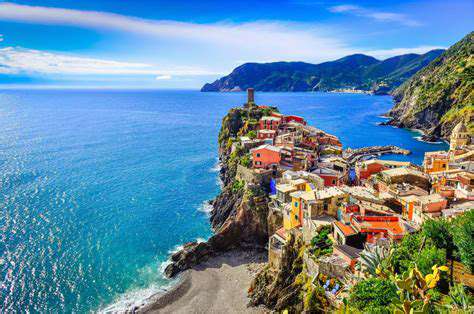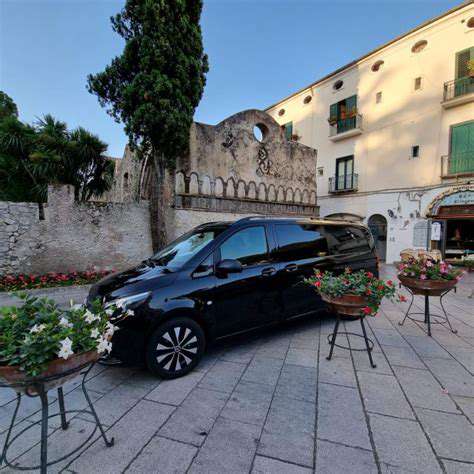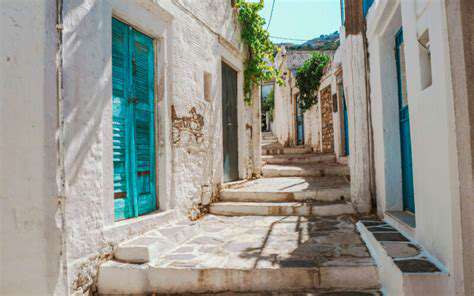Hidden Coastal Towns in Italy to Visit

Exploring the Coastal Charms
Nestled along the Ligurian Sea in northwestern Italy, the Ligurian Riviera unfolds like a watercolor painting come to life. What makes this coastline truly special isn't just its postcard-perfect views, but the way centuries-old fishing villages seem to grow organically from the cliffs. The pastel-hued buildings cascade down steep hillsides in a chaotic yet harmonious dance with nature. Morning brings the scent of saltwater mingling with freshly baked focaccia, while evenings paint the sky in hues that inspired generations of artists.
The Culinary Delights
Liguria's kitchen tells the story of its landscape - where mountains meet sea. The region's signature pesto isn't just a sauce; it's a cultural artifact, born from the necessity of using abundant basil and precious olive oil. Local fishermen still mend their nets at dawn before heading out, returning with catches that transform into dishes where simplicity reveals extraordinary depth. Don't miss the testaroli, an ancient pasta that predates even the Roman Empire, or the delicate stuffed anchovies that showcase Liguria's gift for elevating humble ingredients.
Discovering the History
History here isn't confined to museums - it lives in the cobblestones underfoot and the frescoes peeking from church walls. The strategic importance of these coastal villages becomes clear when you notice the watchtowers dotting the coastline, remnants of defenses against Saracen pirates. In Tellaro, legend says the church bells once rang spontaneously to warn of an impending attack, a story locals recount with pride while sipping sciacchetrà, the region's golden dessert wine.
Hiking and Outdoor Adventures
The ancient salt roads and mule tracks now form a network of trails connecting villages in ways modern roads cannot. Walking these paths feels like stepping into a living map where every turn reveals a new perspective - a hidden cove, a centuries-old olive grove, or a viewpoint where the sea stretches endlessly. The Sentiero Azzurro (Blue Trail) offers particularly breathtaking vistas, though the less-traveled inland routes reveal the region's surprising agricultural heart.
Coastal Villages and Towns
Each village along this coast has developed its own personality. Tellaro charms with its labyrinth of caruggi (narrow alleys) that suddenly open to sea views, while nearby Lerici boasts a castle straight from a storybook. The real magic happens in the piazzas at dusk, when generations gather for the passeggiata - that quintessential Italian evening stroll where news is shared and life is celebrated.
Beaches and Relaxation
The beaches here defy expectations - some accessible only by boat or steep paths, rewarding effort with privacy and natural beauty. Tellaro's spiaggia dei gelsi (mulberry beach) gets its name from trees whose roots grip the cliffs, their shade creating perfect spots to read or sketch. The water's clarity reveals stones worn smooth by centuries of waves, while occasional octopus sightings remind you this remains very much a working fishing coast.
Local Culture and Traditions
Festivals here blend sacred and profane in uniquely Ligurian ways. The sagra del polpo (octopus festival) sees generations sharing recipes while debating fishing techniques. What visitors often miss is the subtle humor in local traditions - like the palio dei rioni where neighborhood rivalries play out through bizarre competitions involving everything from olive pits to church bells. These moments reveal the true soul of the Riviera - proud yet self-deprecating, deeply traditional yet endlessly inventive.
Discovering the Amalfi Coast's Hidden Villages: Exploring the Enchantment of Ravello

Unveiling the Enchanting Beauty
There's a reason Ravello has captivated artists from Wagner to Virginia Woolf. Perched high above the Amalfi Coast, this village offers perspectives that transform ordinary sunlight into something magical - especially when it filters through the wisteria-draped pergolas of Villa Cimbrone's infinity terrace. The microclimate here allows gardens to flourish with species that shouldn't survive at this latitude, creating unexpected botanical surprises around every corner.
Exploring the Historic Villages
Ravello's architecture tells a story of competing influences - Arab-Norman towers stand beside Renaissance palazzos, all built with the local pietra di Tramonti stone that changes color with the light. The cathedral's bronze doors, cast in Constantinople in 1087, still bear the teeth marks of medieval pilgrims who tested their authenticity the only way they knew how. Wandering the backstreets reveals artisans keeping ancient crafts alive, from handmade paper to limoncello crafted from terrace-grown lemons.
Indulging in Culinary Delights
The cuisine here reflects the vertical landscape - dishes designed to sustain farmers working steep slopes. Delicacies like scialatielli (short, thick pasta) cling to sauces better than spaghetti, while the sfusato amalfitano lemon finds its way into everything from risotto to after-dinner digestivos. For a true taste of place, seek out restaurants still using wood-fired stoves and ingredients harvested from the surrounding terraces that morning.
Embarking on Scenic Hiking Trails
The Sentiero degli Dei (Path of the Gods) deserves its heavenly name, but Ravello offers equally stunning walks with fewer crowds. The ancient mule track to Minori winds past abandoned lime kilns and through lemon groves, with occasional glimpses of the sea far below. More adventurous hikers can descend ancient staircases to Atrani, where stopping for a granita at Pasticceria Sal de Riso makes the climb back worthwhile.
Discovering the Hidden Gems
Beyond the famous villas, Ravello hides quieter treasures. The tiny chapel of San Giovanni del Toro contains 13th-century frescoes that survived earthquakes and humidity through sheer luck. Local secret: the best views often come from unmarked paths between houses, where residents might invite you in for a coffee if you ask about their garden.
Experiencing the Local Culture
The Ravello Festival may draw international stars, but the real cultural heartbeat comes from simpler moments. Thursday mornings see farmers trading produce in dialect near the duomo, while elderly women still make lace on their doorsteps using techniques passed down through generations. These unscripted interactions reveal more about Amalfi Coast life than any guided tour ever could.
Uncovering the Sicilian Coast's Secret: Exploring the Charm of Scoglitti
A Coastal Gem: Discovering Scoglitti
Scoglitti feels like Sicily distilled to its essence - a fishing village where life moves to the rhythm of the tides rather than tourist schedules. The harbor comes alive at dawn when brightly painted boats unload their catch, the fish so fresh they're still iridescent in the morning light. Unlike more polished destinations, Scoglitti proudly shows its wrinkles - the weathered facades, the nets drying on the quay, the generations-old rivalries between fishing families.
Historical Echoes: Unveiling the Past
The sea here has always been both provider and threat. The 18th-century tonnara (tuna processing plant) stands as a monument to an industry that once defined this coast, its massive anchors now serving as benches where old men play cards. Local legends speak of Greek ships sheltering in the natural harbor, while the occasional amphora fragment washing ashore reminds everyone that this was once the Mediterranean's crossroads.
Sun-Kissed Beaches and Crystal-Clear Waters
Scoglitti's beaches offer a study in contrasts - the main spiaggia with its orderly rows of umbrellas gives way to wilder stretches where the dunes shelter nesting birds. The real magic happens at Punta Secca, where the shallow shelf creates tidal pools perfect for children and the light takes on that particular golden quality that made this location famous in Inspector Montalbano.
A Culinary Journey: Savor the Flavors of Scoglitti
This is where to experience seafood at its most unpretentious and glorious. The morning's catch might become your lunchtime frittura di paranza (mixed fried fish) or evening spaghetti ai ricci (with sea urchins) depending on what the nets yielded. Don't miss the peculiar local specialty - pane nero di Modica, a dark bread made with ancient techniques that pairs perfectly with the briny flavors of the sea.
Exploring the Local Culture: Immerse Yourself in the Heart of Scoglitti
Festivals here have a raw, visceral quality absent from more polished destinations. The Processione del Cristo Morto on Good Friday transforms the waterfront into a moving tableau of grief and hope, while the summer sagra del pesce turns the piazza into an open-air kitchen where everyone debates the proper way to grill a swordfish. These are moments when Sicily's soul bares itself without pretense.
Discovering Hidden Enchantments: Beyond the Tourist Trail
The true Scoglitti reveals itself to those who linger. Follow the fishermen to their favorite cantina for unfiltered wine poured from unmarked bottles, or discover the tiny shrine to Santa Maria di Portosalvo where generations have left ex-votos in gratitude for surviving storms. The best experiences here can't be found in guidebooks - they're written in the lines on locals' faces and the stories they share over an evening aperitivo.
Relax and Recharge: A Peaceful Retreat in Scoglitti
There's an art to doing nothing Sicilian-style, and Scoglitti provides the perfect classroom. The passeggiata here isn't performative - it's a genuine ritual where the entire town seems to exhale together as the sun dips below the horizon. Find a spot on the breakwater, watch the fishing boats become silhouettes against the twilight, and understand why generations have found solace in this unassuming corner of Sicily.



![Planning a Family Camping Trip [Beginner's Guide]](/static/images/27/2025-04/MakingtheMostofYourCampingExperience.jpg)



